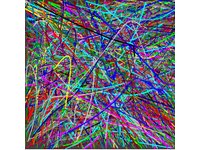2D, Acceleration, And Windows: Aren't All Graphics Cards Equal?
2.5D: The Myth Of 2D Hardware Acceleration
Dedicated graphics cards first became must-haves in a purely two-dimensional realm. It’s no secret that these boards still deliver excellent performance today when it comes to handling complex rendering tasks. Even so, these old cards slow to a crawl in everyday use, especially when it comes to rendering complex graphics effects associated with the latest versions of Windows. On the one hand, this stems from the graphical complexity of modern Windows user interfaces, and on the other, from limited graphical functionality. Let’s tackle these elements, one at a time…
2D Acceleration for Drawing Functions
This section applies to that part of 2D graphics acceleration related to native rendering of graphics output, from GDI through the graphics card itself. This includes simple geometric objects like pixels, lines, curves, polygons, rectangles, and ellipses on the one hand, and their scaling, rendering, or font-smoothing operations (like TrueType or OpenType) on the other.
Early support for hardware acceleration of so-called “2D primitives” in graphics cards is gone, and has been missing from consumer-grade products for some time now. Today, acceleration of two-dimensional graphics functions comes as an analog to three-dimensional acceleration, but is handled solely and completely by graphics driver software rather than on-board hardware.
In the second part of this story, we will introduce and explain a benchmark test that we developed especially for two-dimensional graphics, which tests key and fundamental 2D graphics functions thoroughly. Furthermore, this benchmark shows that driver software exercises blatant and unexpected influence over 2D graphics. We also present a small selection of nine overall test criteria as well.



2.5D Acceleration of GUI Displays
Translation of drawing functions is only a part of two-dimensional acceleration. A noticeable and perceptibly positive acceleration is available from current 3D graphics cards that can render, manage, and display 2.5D graphics information in hardware.
Get Tom's Hardware's best news and in-depth reviews, straight to your inbox.
How does this work? As with 3D displays, both visible and obscured portions of window regions are rendered and stored in their entirety as virtual rectangular regions, and represent a real-time view of the contents for all active windows. Thus, nothing needs to be recalculated when windows move or change; only what was formerly obscured and is now visible needs to be drawn, along with anything that’s changed since the last refresh. The graphics card always knows the size and position of the virtual rectangles represented as windows. Using the "depth buffer" (Z-buffer), the card keeps track of the order and display priority for windows or objects on display (also known as the Z-order). Thus, the graphics card can decide what’s visible and what needs to be rendered on-screen all by itself.
Let’s summarize (and emphasize) what this means:
Current 2D hardware acceleration includes both the implementation of key 2D drawing functions as well as the implementation of 2.5D layering techniques for windows and user interface display.
It would be downright exhausting to examine each and every known Windows version in further detail. Because the current problems that led us to perform these benchmarks occur only with Windows 7, we restricted our testing to Windows XP, Vista, and naturally also, Windows 7 as well.
Current page: 2.5D: The Myth Of 2D Hardware Acceleration
Prev Page The Limits Of 2D: One Space With Many Windows Next Page Windows XP: Old School 2D And The Limits of WM_PAINTTom's Hardware is the leading destination for hardcore computer enthusiasts. We cover everything from processors to 3D printers, single-board computers, SSDs and high-end gaming rigs, empowering readers to make the most of the tech they love, keep up on the latest developments and buy the right gear. Our staff has more than 100 years of combined experience covering news, solving tech problems and reviewing components and systems.
-
pcxt21 Very nice work! Until that little update I was ready to put my old Matrox Millennium (1996/1997 I think) 2d accelerator back into my gaming rig...Reply -
For those who still remember Matrox...shouldn't that be included in the test as well? Ancient history shows that it was the best card to be paired with VooDoo when first released...:PReply
-
one-shot LOL. The clip of Steve Ballmer looks like an ad from the late Billy Mays. To think he's the CEO of Microsoft after watching that clip makes me laugh. I'm going to watch it again.Reply -
chookman I actually went to put a Professional Matrox card (G550 PCI-e) in my Windows 7 machinde for a few more displays... alas it seems most of the range doesnt have Windows 7 drivers yet :(Reply -
Belardo The sad thing is, as shown was that Windows 1.0~3.0 were never an operating system, ever. 1.0~2.x we're never really used by anyone, yet Amigas and Macs had full GUI functionality since 85/84... Windows3 was at least usable, but still a single-tasking POS, and yet MS-DOS was able to dominate the computer industry... not because of talent, but because of luck, good moves by Gates & Ballmer and the stupidity of IBM. It kind of worked out anyway thou.Reply
Think about it, it wasn't until the tail-end of 1995, with the release of Windows95, did MS produce an actual GUI OS for the general public, 10 whole years after Apple's Mac and the Amiga by chicken lips. Atari only copied much of the hardware abilities of Amiga with a variant of a MS-DOS clone.
Only business bought PC-Clones in the 80s~90s, paying around $1500~4000 per desktop. Since IBM didn't make the OS and the hardware was generic, it was super easy for clones to exists. Home users bought Amigas and Macs and laughed as DOS users... but in the end, they lost to the clones.
At one time in 1990, the Computer Shopper Mag was about 500 pages (phone book) with at least 500 Clone companies advertising.
Windows is still the Copy-Cat OS. Its still an ugly beast under the hood. At least Windows7 runs good and looks nice.
-
Raid3r Indeed, way to take one for the team..I am one of those 2d workers and greatly appreciate the foot that was used to affirm the position of 2d recognition on these "new" cards. I can't say it enough.Reply -
micky_lund woot for toms...Reply
catch some more massive companies out, and make them fix up their drivers -
Belardo I just finished reading this entire article. A good one too guys.Reply
While I had my rant about old MS days, I did work in the PC field starting with 3.1. We'd benchmark various video cards with programs that would test lines, boxes, etc. This WAS important for some games like DOOM and Quake which were not "true" 3D cards we have today.
For every new type of PC build or a clients computer, I would save these generic overall system benchmarks. And I *have* notice different 2D performance abilities of computers and the various cards. All super fast compared to the 90s, but I've seen a GF card perform worse than an older ATI, but also an older ATI work a bit better than a newer one. These are all WinXP and don't have anything to do with the problems of Win7 and/or DX11... Part2 isn't out yet... but I would be curious to see if the problems in Win7 happens in Vista with DX11 installed hmmm.
ATI has been putting all their work into 3D gaming performance, its good to see that they have put a team to fix their 2D issues. There is a good chance that this is a DX11 issue they were not aware of. Since Nvidia doesn't have any DX11 parts (but a DX10.5) - this "bug" doesn't yet show... but I'm speculating of course. :)
With the eye-candy of Win7, the 2D performance *IS* important for those doing work, watching videos, etc. No good excuse to miss this, and hopefully ATI will have it resolved in 1-2 months.
PS: Your memory usage chart of vista vs Win7 shows exactly WHY Vist . That is why Windows7 runs pretty good on a 1GB computer, but Vista still needs at least 3GB for a bottom-end PC. My notebook has Win7rc with 1GB, runs fine.
Hey, will your results sometime include intel graphics? After this bug-issue is resolves, include overall-2D scores with your graphics Charts. :)

